FRIDAY, AUGUST 14
■ How early in twilight can you spot Jupiter and then Saturn glimmering into view? Look for them in the south-southeast, as shown below. (To their right, you'll need binoculars to pick out the Sagittarius Teapot stars until twilight is nearly over.)
Later the Jupiter-Saturn pair turns perfectly horizontal, a little earlier each night. How well can you judge when this happens? The exact time will depend on where you live in your time zone. But expect it to happen about four minutes earlier with each passing day.
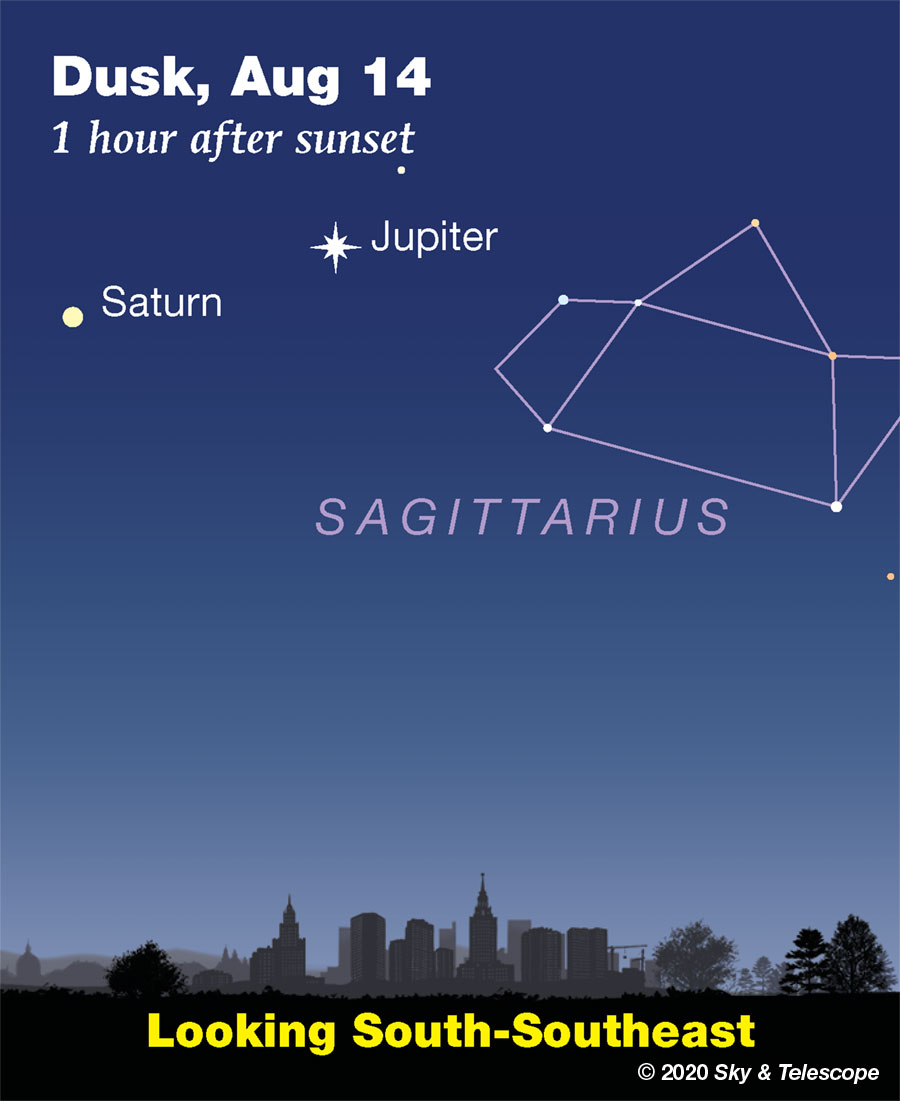
■ Double shadow on Jupiter. Late tonight, Jupiter's moons Ganymede and Io both cast their tiny black shadows onto the planet's face at once from 12:08 to 1:54 a.m. EDT. The central and western states have the most convenient view of Jupiter during the event; subtract 3 hours from those times to get PDT.
And, Jupiter's Great Red Spot should cross the planet's central meridian before then, around 11:26 p.m. EDT.
■ In early dawn Saturday morning, look east for Venus paired beautifully with the waning crescent Moon, as shown below. They're only 3° or 4° apart for the Americas, shining in the dim feet of Gemini.
Look for Castor and Pollux to their lower left. Orion is farther to their right or lower right.
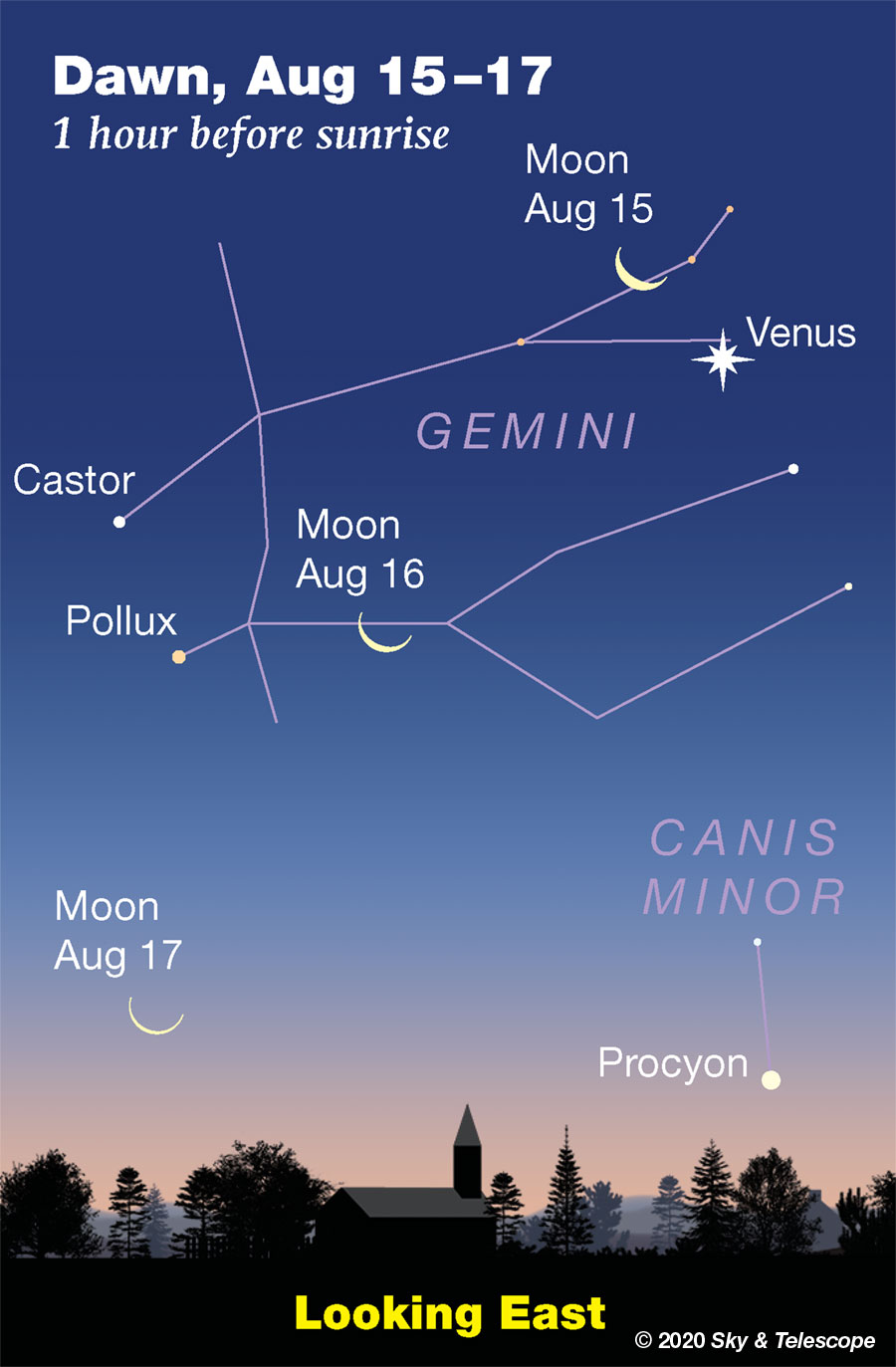
SATURDAY, AUGUST 15
■ August is prime Milky Way time! After dark, the Milky Way extends up from low in the the south (where it runs between the tail of Scorpius and the spout of the Sagittarius Teapot), up and left across Aquila and through the big Summer Triangle very high in the east, and on down through Cassiopeia to Perseus rising low in the north-northeast.
■ Here's a little-known Milky Way sight: In southwestern Scorpius near Lupus, off the deep-sky observer's beaten track, is the modest open cluster NGC 6124. It's 6th magnitude in total, but its stars are scattered across about 0.7°, so it's not much to look at in binoculars or a wide-field scope.
But it ought to be. As Matt Wedel remarks in the August Sky & Telescope's Binocular Highlight (page 43), this cluster is relatively nearby at only 1,700 light years, but it is darkened by at least three different clouds or sheets of interstellar dust along our line of sight to it, as well as dust within the cluster itself. Were the view dust-free, he says, NGC 6124 would shine "as bright and prominent as some of the showier Messier clusters."
Use his chart there to find it. Look immediately after dark; it's quite low and soon to get lower. The farther south you are the better.
■ Early in the dawn of Sunday the 16th, Pollux and Castor shine left of the waning crescent Moon, as shown above.
SUNDAY, AUGUST 16
■ Whenever bright Vega crosses nearest your zenith, as it does soon after dark now, you know that the Sagittarius Teapot is at its highest due south.
Two hours later when Deneb crosses closest to the zenith, it's the turn of little Delphinus and boat-shaped Capricornus down below to stand at their highest due south.
■ In early dawn Monday morning the 17th, you'll find the thin crescent Moon way down under Pollux and Castor, as shown above.
MONDAY, AUGUST 17
■ The brightest star high in the southeast these evenings, high to the upper left of Jupiter and Saturn, is Altair. Look for little orange Tarazed above it by a finger-width at arm's length. Altair is only 17 light-years away. Tarazed (Gamma Aquilae) is a red giant about 400 light-years in the background.
Hardly more than a fist-width to Altair's left is delicate Delphinus, the Dolphin, leaping left: toward the east.
Slightly less far above or upper left of Altair, look for smaller, fainter Sagitta, the Arrow. It too points east.
TUESDAY, AUGUST 18
■ As August proceeds and nights begin to turn chilly, the Great Square of Pegasus looms up in the east, balancing on one corner. Its stars are only 2nd and 3rd magnitude, and your fist at arm's length fits inside it. Down below it, glary Mars rises less than an hour after dark.
From the Great Square's left corner runs the main line of the constellation Andromeda: three stars (including the corner) about as bright as those forming the Square. The line extends left and a bit down.
This whole giant pattern was named "the Andromegasus Dipper" by the late Sky & Telescope columnist George Lovi. It's shaped sort of like a giant Little Dipper with an extra-big bowl, and it's currently lifting its contents upward.
■ New Moon (exact at 10:42 p.m. EDT).
WEDNESDAY, AUGUST 19
■ The actual Little Dipper, meanwhile, is tipping over leftward in the north. It's only 40% as long as the Andromegasus Dipper, and most of it is much fainter. As always, you'll find that it's oriented more than 90° counterclockwise compared to Andromegasus. It's dumping its contents out.
THURSDAY, AUGUST 20
■ As summer progresses and Arcturus moves down the western sky, the kite figure of Bootes that sprouts from Arcturus tilts to the right. The kite is narrow, slightly bent with its top leaning right, and 23° long: about two fists at arm's length. Arcturus is its bottom point where the stubby tail is tied on.
Off to the Kite's right in the northwest, the Big Dipper slants diagonally.
FRIDAY, AUGUST 21
■ Spot the thin crescent Moon low in the west in twilight. Look to its left by about 16° for Spica twinkling into view. Spica, usually considered a star of spring, is heading down and out for the year.
Much closer to the Moon (for the Americas) is fainter Gamma Virginis, shown on the plot below. They're just a degree or two apart as seen at the times of dusk for North America.
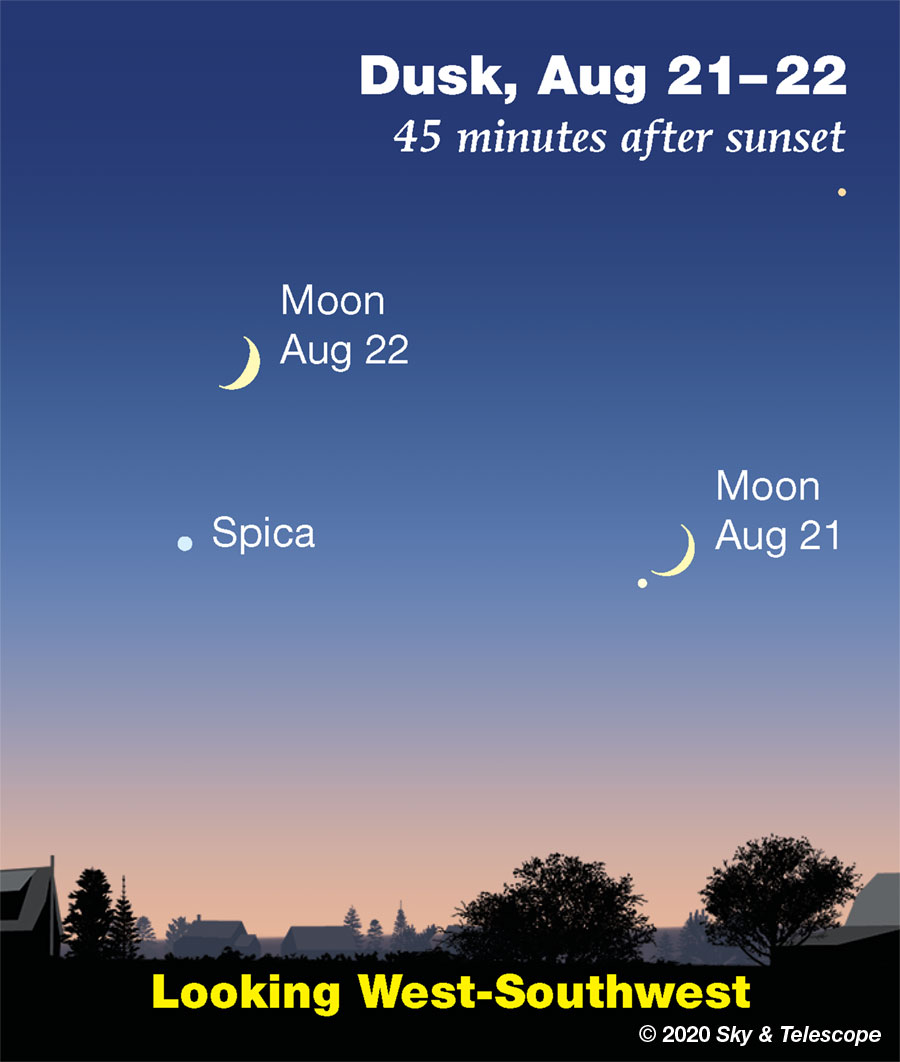
■ Another double shadow transit on Jupiter. On Friday night Io and Ganymede are both casting their tiny black shadows onto the face of Jupiter, this time from 11:32 p.m. to 1:20 a.m. Pacific Daylight Time. This event is for westerners.
SATURDAY, AUGUST 22
■ Late these evenings Fomalhaut, the Autumn Star, makes its inevitable appearance above the southeast horizon. Its rising time will depend on where you live. But by 10 or 11 p.m. now, you should have no trouble identifying it low in the southeast if you have a good view in that direction. No other 1st-magnitude star is anywhere nearby.
This Week's Planet Roundup
Mercury is hidden in conjunction with the Sun.
Venus (magnitude –4.4, in the feet of Gemini) rises in deep darkness about two hours before dawn begins, a weird UFO of a thing in the east-northeast. As dawn gets under way, Venus blazes brightly up in the east. You'll find Castor and Pollux off to its left and Orion farther to its right. The brightest star high upper left of Venus is Capella.
In a telescope Venus is near dichotomy, half lit.
Mars rises in the east about an hour after the end of twilight. It emerges Sirius-bright (magnitude –1.4) and strongly orange, like a far-off bonfire. Where will it come up? Watch the horizon far below the Great Square of Pegasus.
By early dawn Mars shines grandly high and bright in the south, now a high-blown firespark. It's near the dim Knot of Pisces.
In a telescope this week Mars grows from 16½ to 17½ arcseconds in apparent diameter. That's bigger than at some oppositions, but we're still approaching Mars as we speed along our faster orbit around the Sun. When we catch up to and pass Mars at opposition in early October, it will appear 22.6 arcseconds wide and will shine at a Jupiter-bright magnitude –2.6, three times as bright as now.
Mars is still gibbous, 89% sunlit. Look for its white South Polar cap, possible clouds especially near the limb, and subtler dark surface markings. To get a map of the side facing you at the date and time you'll observe, use our Mars Profiler. The map there is square; remember to mentally wrap it onto the side of a globe. (Features near the map's edges become very foreshortened.)
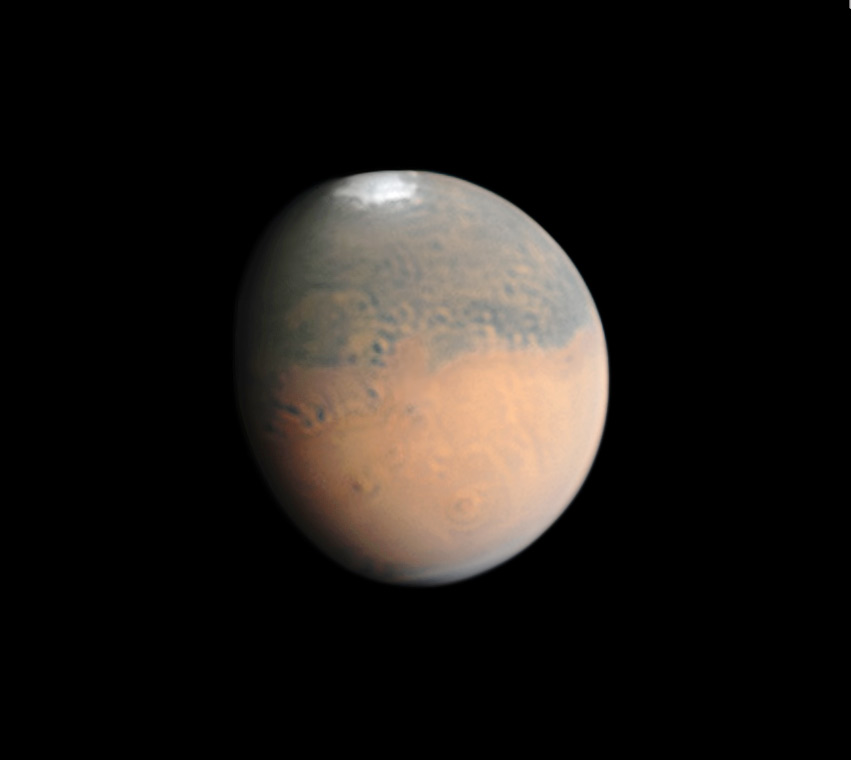
Jupiter and Saturn (magnitudes –2.6 and +0.2, respectively) shine in the south-southeast in twilight. They're highest in the south, for sharpest telescopic viewing, around 10 or 11 p.m. daylight-saving time. Jupiter is the brightest; Saturn is 8° to its left.
Lower right of Jupiter after dark is the handle of the Sagittarius Teapot, as shown at the top of this page.
Follow the telescopic interplay of Jupiter with its moons and their shadows, and find all the transit times of Jupiter's Great Red Spot, in the Celestial Calendar section of the August Sky & Telescope, page 50.
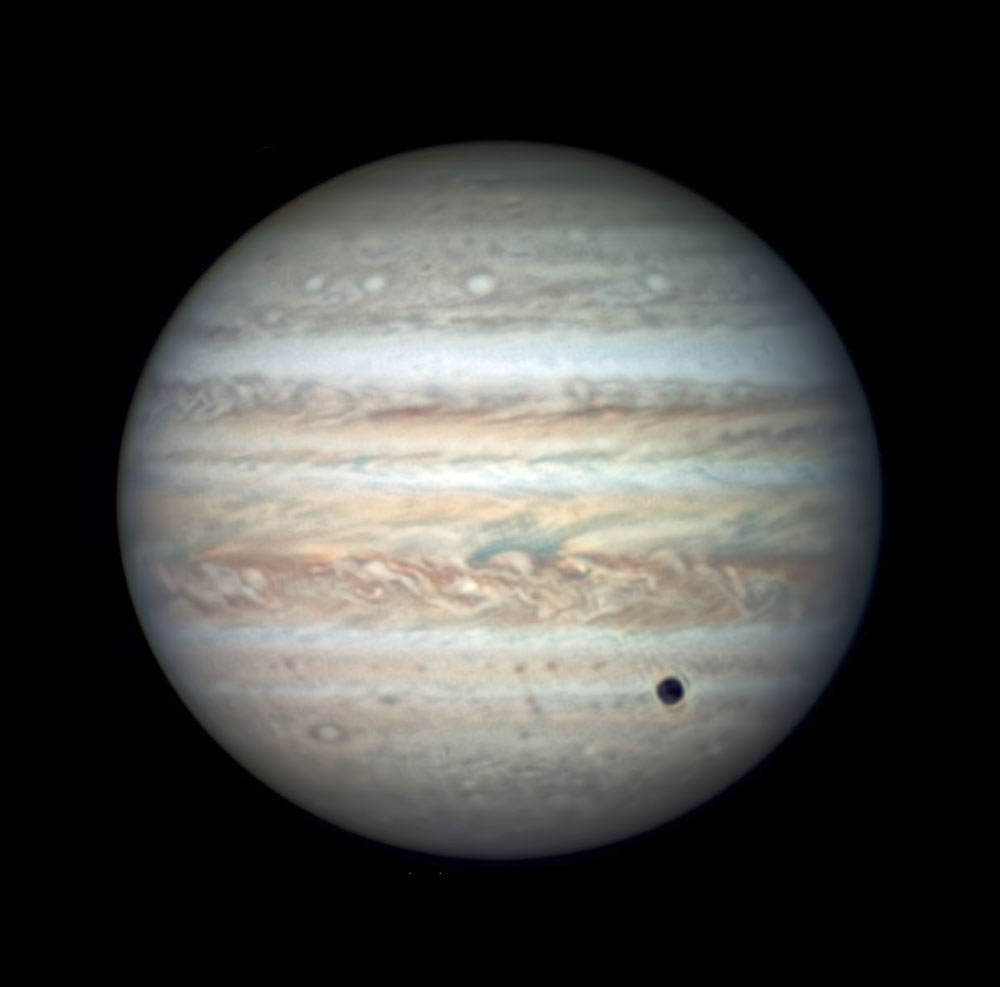
Writes Go, "This is the region [following] the Great Red Spot. The North Equatorial Belt is very active in this region; complex rifts and [white] outbreaks. The South Equatorial Belt is very pale in this region." Callisto is seen in front of the narrow, white North Temperate Zone.
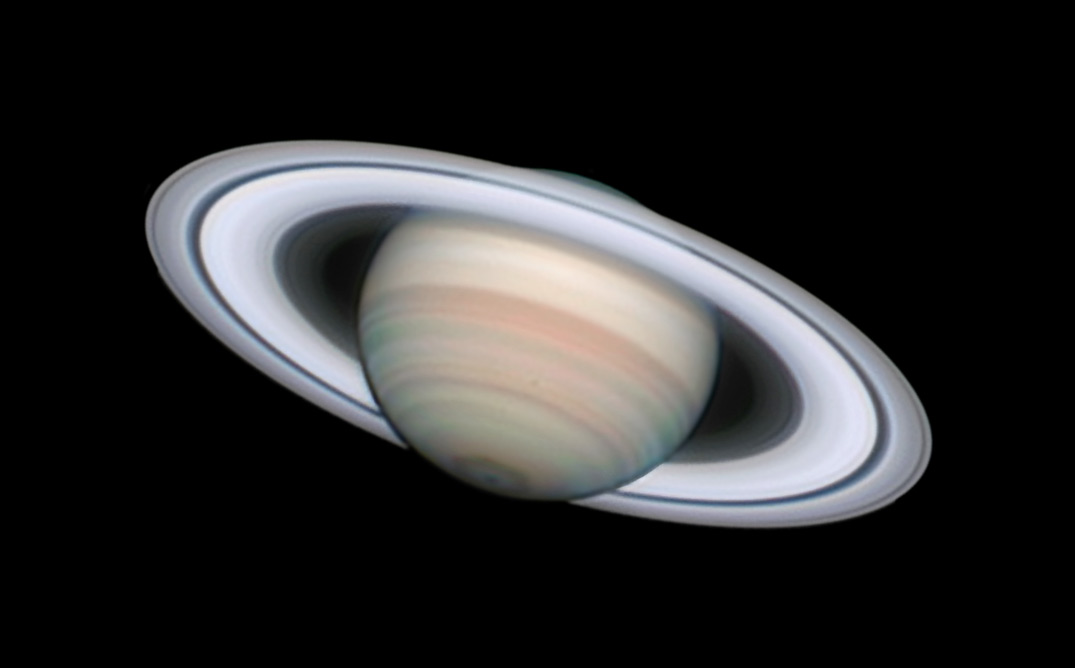
Uranus (magnitude 5.8, in Aries) is well up in the east by midnight or 1 a.m. daylight-saving time, nearly 20° to the celestial east of Mars.
Neptune (magnitude 7.8, in Aquarius) is very high in the southeast by then. Finder charts for Uranus and Neptune.
All descriptions that relate to your horizon — including the words up, down, right, and left — are written for the world's mid-northern latitudes. Descriptions that also depend on longitude (mainly Moon positions) are for North America.
Eastern Daylight Time, EDT, is Universal Time (also known as UT, UTC, GMT, or Z time) minus 4 hours.
Want to become a better astronomer? Learn your way around the constellations. They're the key to locating everything fainter and deeper to hunt with binoculars or a telescope.
This is an outdoor nature hobby. For an easy-to-use constellation guide covering the whole evening sky, use the big monthly map in the center of each issue of Sky & Telescope, the essential magazine of astronomy.
Once you get a telescope, to put it to good use you'll need a detailed, large-scale sky atlas (set of charts). The basic standard is the Pocket Sky Atlas (in either the original or Jumbo Edition), which shows stars to magnitude 7.6.

Next up is the larger and deeper Sky Atlas 2000.0, plotting stars to magnitude 8.5; nearly three times as many. The next up, once you know your way around, are the even larger Interstellarum atlas (stars to magnitude 9.5) or Uranometria 2000.0 (stars to magnitude 9.75). And read how to use sky charts with a telescope.
You'll also want a good deep-sky guidebook, such as Sky Atlas 2000.0 Companion by Strong and Sinnott, or the bigger (and illustrated) Night Sky Observer's Guide by Kepple and Sanner.
Can a computerized telescope replace charts? Not for beginners, I don't think, and not on mounts and tripods that are less than top-quality mechanically, meaning heavy and expensive. And as Terence Dickinson and Alan Dyer say in their Backyard Astronomer's Guide, "A full appreciation of the universe cannot come without developing the skills to find things in the sky and understanding how the sky works. This knowledge comes only by spending time under the stars with star maps in hand."
![]() Audio sky tour. Out under the evening sky with your
Audio sky tour. Out under the evening sky with your
earbuds in place, listen to Kelly Beatty's monthly
podcast tour of the heavens above. It's free.
"The dangers of not thinking clearly are much greater now than ever before. It's not that there's something new in our way of thinking, it's that credulous and confused thinking can be much more lethal in ways it was never before."
— Carl Sagan, 1996
"Facts are stubborn things."
— John Adams, 1770
 7
7








Comments
mary beth
August 14, 2020 at 2:25 pm
I have always thought of Spica as a ‘growing season‘ star, all the way from planting time to harvest time. I especially enjoy the folklore about Corvus the Crow eager to snatch the precious grain of wheat out of the virgin’s hand.
From the online entomology dictionary:
Spica: (1728), bright star in constellation Virgo, from Latin, literally "ear of grain" corresponding to Greek stakhys. As the ancients visualized the constellation, she held an ear of grain.
You must be logged in to post a comment.
Rod
August 14, 2020 at 8:57 pm
mary beth. Good to see you are enjoying some stargazing. Weather for me has been difficult lately in Maryland. T-storms, clouds, light showers, higher humidity at night, etc. I did enjoy some Perseid meteor observations early mornings of 10-11 Aug as well as telescope observations of Mars at 179x along with the Moon. On 12-Aug, I observed sunspot AR2770, rapidly decaying and fading away using my glass, white light solar filter and 90-mm telescope. Hopefully, next week looks like better weather, Monday night mostly clear and after that, some more clouds and likely rain 🙂 I have been cutting, cutting, weed whacking, and cutting 🙂
You must be logged in to post a comment.
mary beth
August 15, 2020 at 12:39 am
Hi Rod! It looks like a lot of the Atlantic storms have come up your direction instead of into the Gulf. We are actually getting a very rare August cool front Monday. Our dewpoints are usually in the high 70s from June through September, so I am really looking forward to lower dewpoints even if the temperature doesn’t drop that much.
Sadly I never saw a meteor and neither did anyone else I know here in Houston. Hopefully your weather will improve very soon, and maybe the grass will quit growing so quickly as well!
One little note I made to myself this week is that I noticed the ‘cats eyes’ in Scorpius cross the Meridian exactly 1 hour later than Antares. Shows how large that constellation is!
If it’s clear tomorrow night as predicted I am going to see if I can see Fomalhaut before midnight.
Hope you have a nice weekend!
You must be logged in to post a comment.
misha17
August 15, 2020 at 12:52 am
Like the Big Dipper, the leading (westernmost) stars of "the Andromegasus Dipper" point to the North Star. In fact, both pairs of leading stars are almost exactly 12hr RA apart.
You must be logged in to post a comment.
mary beth
August 16, 2020 at 2:32 pm
Interesting! I just looked at it on Stellarium.
You must be logged in to post a comment.
Rod
August 17, 2020 at 1:36 am
mary beth et al. The weather cleared up for me on Sunday night and early this morning on Monday. I went out from 2200-2300 EDT and enjoyed telescope views (90-mm refractor) of Saturn, Jupiter, and M22 globular cluster (some outer halo stars visible in the FOV). I viewed at lower power, 40x wider field of view. I could see 6 moons tonight in the solar system, 2 at Saturn with its rings and 4 at Jupiter (some cloud belts visible too), two gas giant planets in the solar system, and one globular cluster, M22. 9 targets observed and more if the multiple stars visible in FOV around Saturn, Jupiter, and M22 are counted 🙂 Later from 0000-0100 EDT, I examined Mars at 179x views. Dark surface areas above the south polar cap very distinct as well as the south polar cap region. Even though Mars was not very high elevation angle when I viewed (< 30 degrees), Mars was a nice target. Slightly orange-yellow color in the FOV. Mars distinct gibbous shape planet too.
You must be logged in to post a comment.
mary beth
August 20, 2020 at 3:38 pm
Sounds like that one night made up for all the nights you missed due to bad weather! Glad you had clear skies!
I’m going to stay outside a little bit later to try to see Fomalhaut tonight. Love that harbinger of autumn… It’s so hot here that any relief, even mentally, helps!
You must be logged in to post a comment.
You must be logged in to post a comment.